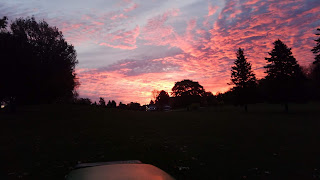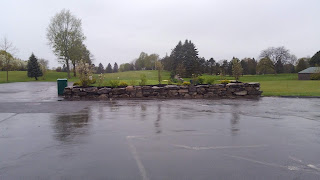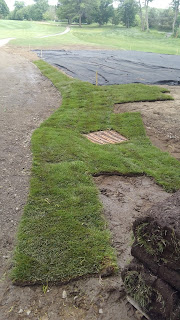Leaves on the ground out number what's left on the trees these days and the crew's thinning out which means it's a good time to look back over the season to see how we got here.
 |
| Cool nights+no rain = perfect conditions |
Weather-wise, 2019 was an average year for temperatures but well over normal for rainfall during the first half of the season. That meant some good and bad for the course. On the bad side: playing conditions tend to be plush and thick. Too much water (from rain or irrigation) gets grass pumped up like a bouncy house which looks fantastic but tends to be difficult to play from. Greens slow and often are too soft and might be mowed one day and skipped the next. Speeds become variable and what rolled well enough in the morning never lasts late enough for league or afternoon play.
 |
| Red skies at morning, sailors take warning |
 |
| Too much rain too fast is a resource burner |
 |
| Hot nights+heavy rains = disease pressure |
The upside of above normal rainfall is the rough never went dormant and I know how our members love our rough. We also will save on the water bill which can be exorbitant on dry years.
Tournament Conditions
Sometimes 'tournament conditions' is a term thrown around a little too readily in the business or gets understood as 'tricking the course up' which is understandably frustrating for the daily player. All it really means to the Superintendent is firming the course up (if possible) and timing your cultural practices so that their effect has maximum value. It's more a 'period of time' when all the planets and stars align rather than something you can whip out of your back pocket.
Backhanded compliments like "why can't the course be this nice all the time" demonstrates the misconception about what's really happening and why it's often unsustainable (and hard to afford) for daily play. So here's a quick primer on tournament preparation, consequences of it, and how it differs from preparing for daily play.
 |
| Perfectly edged and raked bunkers take time and experienced operators |
 |
| Jenny Chuasiriporn at the 1998 US Women's Open. Number of employees for 18 holes that week = 60 |
From a conditioning standpoint a common goal is to have the firmest surface possible. 'Tournament ready' greens are hard under foot. This stems from witholding water and excessive rolling (compaction) and it's undesirable at certain times of the year. Firm surfaces allow mowers to cut at their most accurate which makes consistency and playability from tee, fairway and green the best it can be. It also demands a specific shot type and player ability. It's a hedge for rain as well, as you can always slow greens down with water, but it's hard to get speeds back up once a rain has gone through.
- Drier is a liability for recovery from cart and foot traffic.
- Average shots bounce off greens
- Ballmarks are hard to see and fix
- Plants lack moisture to cool themselves
- Margin for error in care is exponentially higher.
 |
| Cultural practices like aerifying slow greens down but are necessary throughout the season |
Cultural practices
When a tournament date is two weeks away, cultural practices cease and the focus is on maintaining quality of cut. Any aerifying, venting, topdressing, or fertilizing needs to have happened already so surface disruption and growth is minimized. Execution of daily duties is scrutinized and tuned. Extra care is taken around every procedure as there's less time to fix things close to the tournament date. The best operators are put on the jobs they're specialized in doing to ensure the job is consistent. Anything that could disrupt uniformity is avoided.
 |
| Make mistakes early - not the week of the tournament and use your best operators for the most crucial jobs |
- Operators change through the seasons to meet different demands. The best person for the job isn't always available.
- Cultural practices that impact play must be performed during the season or quality declines - disruption is necessary.
- Postponing cultural practices risks a precedent that leads to practices being abandoned altogether -- "we didn't aerify last year and things were fine, can we skip it this year?"
"So how come the course can't be like this all year?"
Many facilities mistakenly market themselves as being in 'tournament condition' all year because being in 'tournament condition' is subjective and hard to prove otherwise. It sounds good, but ultimately means nothing and is a hollow brag.
 |
| Fall golf is best golf |
When greens are growing slowly and getting ready to go dormant is when they're at their easiest to manipulate. Late summer to early fall golf, in other words, is the most common time to have the best conditions. Having the Mid-Am state championship here in late September with cool temperatures, postponing aerification and no rain for a month allowed the greens to be pushed harder for longer. The course played amazing for weeks. It allowed us to use stronger growth regulators that effectively shut the plants down. Those cool nights matter and allowed for a lot of sin to go unnoticed. Trying that in mid July when you need the recovery from the heat and stress of the day would be walking a tightrope with nothing to show for it except weak turf. The return doesn't outweigh the risk at that time of year.
Hot and steamy conditions generally wreak havoc. They're conditions that set Superintendents teeth on edge because so much control is lost when turf is 'juicy'. Downpours followed with humid nights makes the likelihood of firm and fast surfaces a fantasy. At that point, in the middle of summer we're happy to just have plants that are alive and growing after some of the heat and wet experienced through the summer. Turning the screws down on greens to get 'tournament conditions' during those times is reserved for major events. What constitutes a major event is up to the Board of Directors with a cautionary appeal that if every event is deemed 'major' then none are.
In the end, we aim for the highest level of quality we can afford and sustain it for as long as possible.
Projects
A few projects were open over the winter and we're happy to see their completion.
8 Tee
 |
| Roughing it in |
 |
| Half way |
 |
| In play |
1 tee
 |
| Sparrow rookery |
 |
| Native rocks |
 |
| Just planted |
 |
| Fall colors - size will come |
7 Tee
 |
| Fighting weather |
 |
| Finally! |
Moving On
Projects are so much easier with a great crew and our especially able Assistant Superintendent Justin Chunco. Justin is continuing his career and moved on to the head Superintendent's position for The Pompey Club. He'll do great things there. We wish him luck and welcome our newest addition to the grounds department, Scott Winkleman. Scott is a Skaneateles native and will join us in January. He currently manages the Wells College Golf Course in Aurora.



































